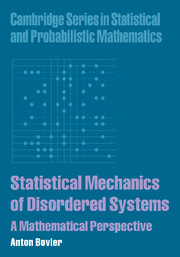Book contents
- Frontmatter
- Contents
- Preface
- Nomenclature
- Part I Statistical mechanics
- Part II Disordered systems: lattice models
- Part III Disordered system: mean-field models
- 8 Disordered mean-field models
- 9 The random energy model
- 10 Derrida's generalized random energy models
- 11 The SK models and the Parisi solution
- 12 Hopfield models
- 13 The number partitioning problem
- References
- Index
8 - Disordered mean-field models
Published online by Cambridge University Press: 25 January 2010
- Frontmatter
- Contents
- Preface
- Nomenclature
- Part I Statistical mechanics
- Part II Disordered systems: lattice models
- Part III Disordered system: mean-field models
- 8 Disordered mean-field models
- 9 The random energy model
- 10 Derrida's generalized random energy models
- 11 The SK models and the Parisi solution
- 12 Hopfield models
- 13 The number partitioning problem
- References
- Index
Summary
Les mathématiques ont un triple but. Elles doivent fournir un instrument pour l'étude de la nature. Mais ce n'est pas tout: elles ont un but philosophique et, j'ose le dire, un but esthétique.
Henri Poincaré, La valeur de la science.In the previous chapters we have seen that with considerable work it is possible to study some simple aspects of random perturbations of the Ising model. On the other hand, models that are genuinely random and promise to bring some new features to light are at the moment not seriously accessible to rigorous analysis. In such situations it it natural to turn to simplified models, and a natural reflex in statistical mechanics is to turn to the mean-field approximation. In the case of disordered systems, this has turned out, quite surprisingly, to open a Pandora's box.
The common feature of mean-field models is that the spatial structure of the lattice ℤd is abandoned in favour of a simpler setting, where sites are indexed by the natural numbers and all spins are supposed to interact with each other, irrespective of their distance. The prototype of all such models is the Curie–Weiss model, that we studied in Section 3.5.
We now turn to the question of what should be the natural class of disordered mean-field models to study? This question requires some thought, as there are at least two natural classes that propose themselves.
- Type
- Chapter
- Information
- Statistical Mechanics of Disordered SystemsA Mathematical Perspective, pp. 161 - 164Publisher: Cambridge University PressPrint publication year: 2006

